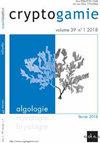建立南极半岛西部海洋绿色巨藻多样性的知识:来自两个分子标记的数据揭示了两极分布的大量物种
IF 1.5
4区 生物学
Q3 MARINE & FRESHWATER BIOLOGY
引用次数: 2
摘要
与红藻或褐藻相比,南极绿色海洋大型藻类(绿藻)的多样性和地方性水平较低。然而,最近的研究,包括分子标记的使用,使我们能够重新审视物种的分类地位,这些物种被认为是众所周知的,在局部和区域尺度上存在意想不到的南极植物群多样性。在本研究中,对南极半岛西部(从62°S到66°S)的绿色大型藻类样本进行了测序,并对绿藻中常用的两种遗传标记(即质体基因tufA和rbcL)进行了测序。在122份蓝藻标本中,85份进行了tufA基因测序,16份进行了rbcL基因测序。使用NCBI核苷酸爆炸工具将我们的序列与公共数据库中的序列进行比较,鉴定出了11个物种。该地区报告了3个新种:罗氏根茎(Rosenvingiella radicans, k本文章由计算机程序翻译,如有差异,请以英文原文为准。
Building-Up Knowledge on Green Marine Macroalgae Diversity in the Western Antarctic Peninsula: Data from Two Molecular Markers Reveals Numerous Species with Amphipolar Distribution
ABSTRACT Low levels of diversity and endemism, when compared to red or brown algae, have been reported for Antarctic green marine macroalgae (Chlorophyta). However, recent studies including the use of molecular markers have allowed us to revisit the taxonomical status of species thought to be well known, underlying the existence of unexpected Antarctic flora diversity at local and regional scale. In the present study, samples of green macroalgae along the Western Antarctic Peninsula (from the 62°S down to the 66°S) were sequenced for two genetic markers regularly used for species determination and barcoding in Chlorophyta (i.e., the plastid genes tufA and rbcL). From the 122 specimens of Chlorophyta sampled, 85 were sequenced for the gene tufA and 16 for the gene rbcL. Using the NCBI Nucleotide Blast Tool to compare our sequences to the ones available in public data depositories allowed the identification of 11 species. Three new species were reported for the area: Rosenvingiella radicans (Kütz.) Rindi, L.McIvor & Guiry, Urospora wormskioldii (Mertens) Rosenvinge and Ulvella islandica R.Nielsen & K.Gunnarsson. Furthermore, molecular identification revealed strong match (> 95%) between our Antarctic sequences and the ones obtained for samples from the northern hemisphere for Acrosiphonia arcta (Dillwyn) Gain, Prasiola crispa (Lightfoot) Kützing, Prasiola antarctica Kützing 1849, R. radicans, Ulva sp. A-GW, U. islandica, Urospora penicilliformis (Roth) Areschoug and U. wormskioldii confirming the amphipolar distribution of various taxa of Antarctic Trebouxiophyceae and Ulvophyceae. Amphipolar distribution seems more common in green than red or brown Antarctic seaweeds, so here we hypothesize that recurrent occurrence of long dispersal events could explain the low level of endemism observed for this phylum along the Antarctic coasts.
求助全文
通过发布文献求助,成功后即可免费获取论文全文。
去求助
来源期刊

Cryptogamie Algologie
生物-海洋与淡水生物学
CiteScore
2.60
自引率
7.70%
发文量
11
审稿时长
>12 weeks
期刊介绍:
Cryptogamie is a fast-track and peer-reviewed journal of international scope publishing in English only. It accepts original papers and review articles on the taxonomy, biology and ecology of all cryptogams. An issue of Cryptogamie may be devoted to a single topic, under the responsibility of guest editor(s). All articles published in Cryptogamie are compliant with the different nomenclatural codes. A copyright assignment will be signed by the authors before publication.
Cryptogamie, Algologie accepts articles on systematics as well as ecology and evolution of any kind of algae (including Cyanobacteria).
 求助内容:
求助内容: 应助结果提醒方式:
应助结果提醒方式:


